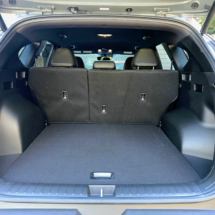
The 2024 Hyundai Tucson stands out in the crowded field of compact SUVs for its handsome looks, roomy and upscale cabin, good fuel efficiency, and many standard features and tech that can cost more on rivals. While it’s not an athletic performer, the Tucson is well-rounded and well-equipped and provides good value for the money. It’s also available with a gas-powered engine, or as a hybrid or plug-in hybrid.
Base Price: $35,575
As Tested: $37,120
Horsepower: 187
Mileage: 23 mpg city/29 mpg highway/25 mpg combined
The Tucson was redesigned for the 2022 model year. There were no major changes for 2023. For 2024, the trim lineup changes with the performance-oriented N Line now only available as a hybrid. The 2024 Tucson also gets standard haptic steering wheel feedback that alerts the driver if the vehicle starts to veer out of its lane or might be in a collision.
The 2024 Tucson comes in four trims: SE, SEL, XRT and Limited. Starting prices range from $27,500 to $36,760 for front-wheel drive and $29,000 to $38,260 for all-wheel drive. There’s room for five passengers in two rows of seating.
The 2024 Tucson is also available as a hybrid and plug-in hybrid. The hybrid is available in four trims: Blue Hybrid AWD, SEL Convenience Hybrid AWD, N Line Hybrid AWD and Tucson Limited Hybrid AWD. Starting prices for the hybrid are $32,575 to $39,715.
The plug-in hybrid comes in two trims: SEL Plug-in Hybrid AWD and Limited Plut-in Hybrid AWD. Starting prices are $38,725 and $45,450, respectively.
This review covers the gas-powered Tucson.
The powertrain is a 2.5-liter four-cylinder engine that makes 187 horsepower and 178 pound-feet of torque. The transmission is an eight-speed automatic. There’s enough power for driving around town, but theTucson has slow acceleration which is very noticeable when trying to speed up for merging or passing on the freeway. The ride is smooth with the suspension soaking up bumps, and the Tucson feels planted when cornering. Steering is accurate and brakes are responsive. The Tucson’s relatively small turning radius makes it easy to squeeze the Tucson into tight parking spaces. All in all, the Tucson is easy to handle but if peppy performance is important to you, the Tucson won’t be your first choice.
Fuel efficiency is a bit better than average for a compact SUV. EPA ratings for my AWD tester are 23 mpg city, 29 mpg highway and a combined rating of 25. I got 26 mpg during my week with a mix of city and highway driving. Front-wheel drive models do a bit better at 25 mpg city, 29 mpg highway and 25 mpg combined.
The cabin is one of the best in the class with an upscale look and feel. Materials are nice and many are soft-touch. The design is clean and modern. The cabin is quiet as a library with road and wind noise barely noticeable. Front seats are supportive and comfortable and passengers in both rows enjoy good leg- and headroom.
Standard features include remote keyless entry, rearview camera, cloth upholstery, manually adjustable front seats, analog gauge cluster, infotainment system with eight-inch touchscreen, six-speaker audio system, HD Radio, wireless Android Auto and Apple CarPlay, Bluetooth, two USB ports, and automatic high-beam headlights.
Available features include proximity keyless entry, push-button start, digital key, surround-view camera system, dual-zone automatic climate control, synthetic leather upholstery, real leather upholstery, power-adjustable driver’s seat, power-adjustable passenger seat, heated and ventilated front seats, heated steering wheel, heated rear seats, 10.25-inch digital gauge cluster, infotainment system with 10.25-inch touchscreen, navigation, eight-speaker audio system, satellite radio, two additional USB ports, wireless device charging, ambient lighting, and a sunroof.
Standard driver assistance technologies include forward collision warning with pedestrian and cyclist detection, forward automatic emergency braking, adaptive cruise control, lane-departure warning, lane-keep assist, blind-spot monitoring, rear cross-traffic alert, rear-seat alert, and driver-attention monitoring.
Available driver assistance technologies include Hyundai’s Highway Driving Assist (adaptive cruise control with lane centering), blind-spot camera (which shows video of the vehicle’s blind spots when you activate a turn signal), front and rear parking sensors, and remote smart parking assist.
The infotainment system is mostly user-friendly, whether you have the standard eight-inch or available 10.25-inch touchscreen. Graphics look sharp and the system responds quickly to touch and voice commands. The smaller screen has physical controls for things like audio and climate settings, while the larger screen incorporates these controls on the touchscreen with touch-capacitive buttons – these take some getting used to.
Cargo space is excellent for the class. The Tucson has 38.7 cubic feet of storage with both rows of seating in pace, and a whopping 74.8 cubes with the second row folded. A manual liftgate is standard and a hands-free power liftgate is available.
The good:
Easy handling
Smooth ride
Many standard features and tech
Roomy, upscale interior
Lots of cargo space
The not-so-good:
Lackluster acceleration
Pricing info:
My tester starts at $35,575. Carpeted floor mats are $210. Destination fee is $1,335 bringing the grand total to $37,120.
Bottom line:
The 2024 Hyundai Tucson checks a lot of boxes when it comes to picking a compact SUV. It has stylish looks, an upscale and spacious cabin with many standard features and tech, plenty of cargo space, a smooth ride, and good fuel efficiency, all at a reasonable price. The one drawback is its leisurely acceleration.






















